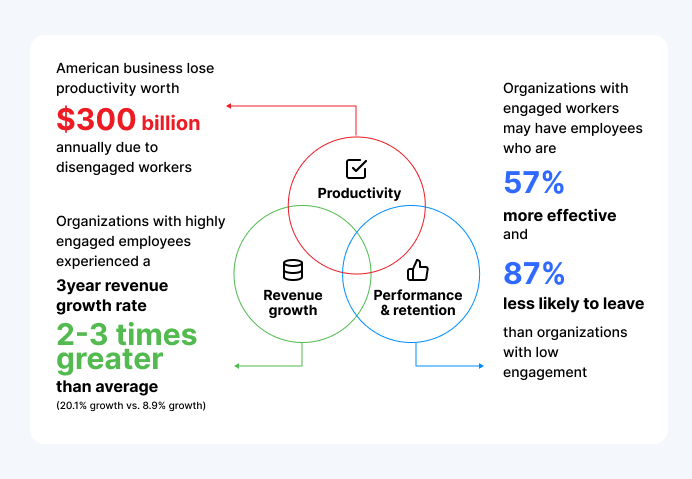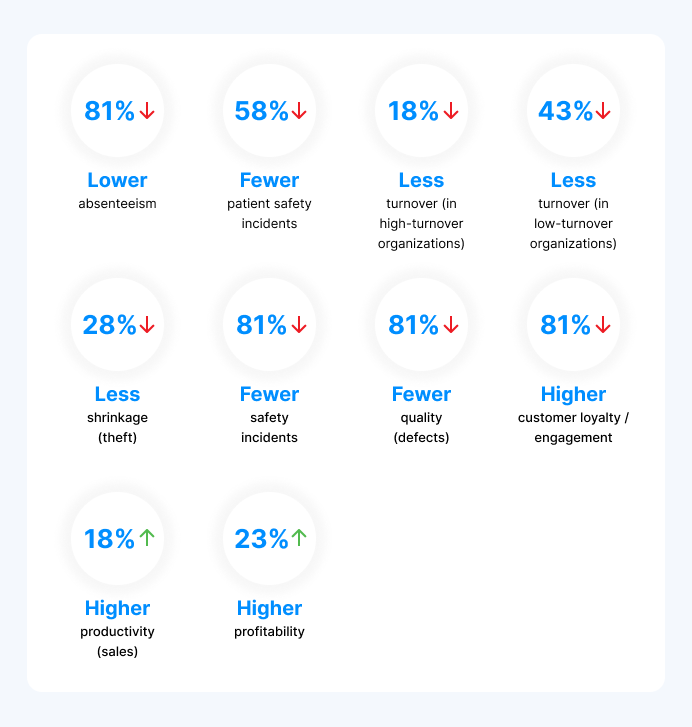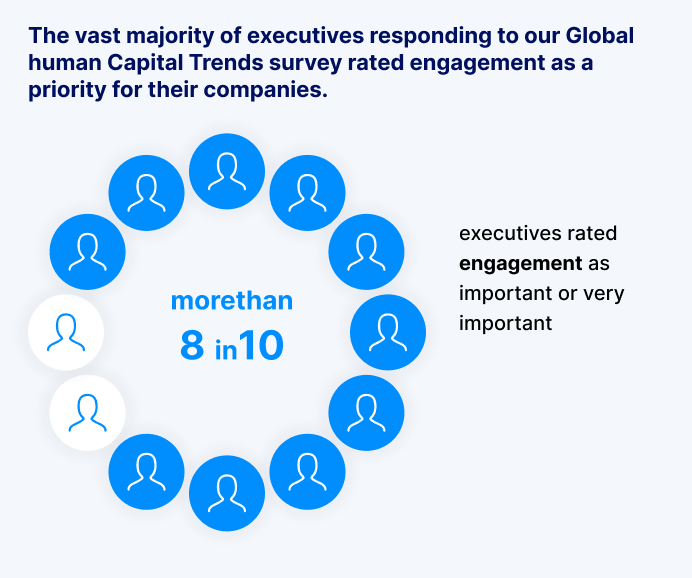The 10 Pillars of Employee Engagement in 2025
Employee Engagement is about understanding, motivating, and connecting people. Here are the 10 pillars of employee engagement for a happier, higher potential, and more productive workforce.
On this page
Employee engagement defines an employee's emotional commitment and responsibility towards their work and the employer. A Gallup report has concluded that 23% of employees feel engaged at work.
Despite the trends, Gallup has also showcased the need to strengthen the pillars of employee engagement, as empirical evidence suggests that higher levels of engagement have a profound impact on an organization’s success.
Therefore, it is disappointing that only 15% of global employees (and only 35% in the US) consider themselves engaged.
According to a Deloitte report, employee engagement affects several areas: productivity, revenues, performance, and even employee retention.

Therefore, companies must improve employee engagement to optimize the enormous latent potential of a more engaged workforce.
Management must focus on understanding the causes of employee engagement and seek ways to eliminate the barriers to better employee-company alignment.
10 most important pillars of employee engagement
Some considerations for better employee enablement are:
1. Communication
Communication lies at the heart of any effort to improve engagement and to create a positive company culture. It engenders trust, transparency and enhances worker morale. Effective communication requires calibrating plans to respond to employee feedback.
Assuming that employees have what they need to do a good job can be a fatal flaw. And not acknowledging employee needs or impediments can snowball into more caustic problems like poor morale.
Today, communication also means incorporating various technology tools and creating safe spaces for candid non-threatening conversations. Remote and hybrid work is creating a new emphasis on innovative ways to enhance communication.
Companies would do well to institute some ground rules for their communication protocols lest communication becomes a perpetual activity required at all times of the day and night. Yes, that means beginning with communicating about how and when to communicate!
2. Work environment
In an era where work environments are the subject of online employee reviews on sites like Glassdoor, negative feedback can impede employee retention and hiring. Toxic settings are easily identified and highlight poor employee engagement.
Non-engaged employees are unenthusiastic about their work and are most likely to leave at a moment’s notice. They also tend to poison the well and be highly critical of a company that does not meet their needs. Their negative influence invariably manifests itself in poor team performance and adverse customer interactions.
3. Collaboration
And while you obviously cannot force employees to be friends, you can create more opportunities for casual interactions to encourage such bonds to be established. Teams, where individuals get on with each other, tend to be happier and more productive.
The new hybrid work environment means that all employees are not likely to be in one place, as was the case pre-pandemic. Effective collaboration requires the selection of the right digital tools for a dispersed workforce.
In this respect, technology companies have done a yeoman’s job and have had great success in facilitating the future of work in trying circumstances. There are a plethora of options. Zoom is now a verb!
4. Rewards and incentives
Rewards and incentives are an essential part of the employee engagement toolbox. But a lot has changed post-pandemic. Not surprisingly, employees have a somewhat different take on their expectations from work.
The post-pandemic era allows companies to rethink total rewards and make changes to employees’ financial and non-financial rewards to fit this new environment.
Appreciating employees, particularly when they are going above and beyond, is a powerful incentive to continue to do better. It shows that managers are noticing their excellent work and rewarding it.
Even before the pandemic, the American Psychological Association estimated that more than $500 billion was lost due to workplace stress. Stressed employees also tend to have higher absenteeism and higher turnover. And turnovers are costly.
The Center for American Progress estimates that replacing a single employee costs approximately 20% of that employee’s salary.
The stresses of 2020 have put renewed focus on employee wellbeing. Wellness programs as employee enablement incentives have always provided a great return on investment, but now, 86% of organizations have a dedicated budget for workplace wellbeing. Rewards are changing.
5. Personal development
In the current setting, technology allows for more training and reskilling options than ever before. When employees are happy, engaged, and feel supported by their leadership and management, they tend to produce their best work.
Engagement is about the individual’s personal development, but it is helpful to remember that employee development directly benefits the organization too.
A culture where continuous learning is encouraged creates agile organizations that move at the speed of the competition and the market. Not leveraging these learning options for employees is a poor excuse for employers and can cause existential threats to the company.
6. Role definition
Employees need to understand and articulate management’s expectations of them if they are to succeed. Providing such clarity needs to be the responsibility of the manager. When positions are unclear, employees don’t know how their work contributes to success, leading to confusion and frustration.
In the new models for the future of work, role definitions tend to emphasize the end product/service. Expectations and even delegation of tasks now need to be redefined for this new reality.
Finally, now more than ever, the work and role definition must fit into the employee’s expectations of their own lives. Understanding the individual’s personal choices and helping them connect those objectives with the company goals is paramount.
7. Support from leadership
Employee engagement requires board and management buy-in and investment. Employees need to see that their C-Suite is vested in the success of the engagement strategies and plans. Only then will they trust the effort and commit themselves to the engagement framework.
Gallup’s data (see below) shows that engaged employees work safer, work longer, produce better quality products and services and lead to higher company profitability.

This sampling of outcomes should remove any doubts about why leadership and management should not enthusiastically support and encourage better employee engagement. It directly impacts the bottom line!
8. Alignment with company goals
Increasingly, employees are not just satisfied with a paycheck. They want to find meaning and purpose in what they do, including in meaningful work. The younger generations now entering the workforce are even more focused on this aspect of their lives.
Helping employees understand how their work affects the bigger picture is a crucial role of managers. Performance reviews should focus on ways in which an employee can better meet the objectives of the organization.
9. Surveys/feedback
You will not fix the problems of employee engagement until you have determined why it is occurring. Surveys are a handy tool in determining what is deficient by giving everyone a chance to provide input and reassure staff that you are taking their feedback seriously.
Listening is great, but you also need data. Surveys help you collect that data. There are many options in the marketplace for employee surveys. One such tool comes from Xoxoday and incorporates both eNPS and engagement methodologies.
Baselining the various components of employee engagement and then using KPIs to evaluate feedback and progress is critical. Ensuring employees opine whether they have the resources, tools, and technology to do their jobs well is essential feedback.
Once-and-done does not provide the continuous always-listening mode that provides the best data and results.
And remember, you will do more damage to company culture if you do nothing about what your employees are telling you. Feedback needs to spur you to action and not into an “analysis paralysis.”
10. Growth opportunities/mentoring
Employees are looking for ways to add value to their work and positively impact their career progression. Managers need to encourage employees to achieve higher performance with effective coaching techniques and employee training opportunities.
Some of this is a function of encouraging trusted conversations where employees are not fearful of the consequences of what they might say.
Managers who have continuous conversations with employees and clarify how an individual’s work leads to organizational success are likely to create more enthusiastic and engaged employees.
It is a familiar adage that people quit managers, not their jobs. Managers should improve their ability to show empathy to their employees.
In Give and Take, Prof. Adam Grant of Wharton demonstrates how a leader’s kindness can be a powerful indicator of team success and enables employees to perform at optimum levels.
How Xoxoday's employee engagement platform strengthens all 10 pillars
Creating a culture where employees are truly engaged isn’t just about perks or paychecks—it’s about building deep connections across the key pillars that drive fulfillment, motivation, and purpose at work. That’s exactly what Xoxoday's employee engagement platform, Empuls is built for.

Empuls is a comprehensive, AI-powered employee engagement platform that enables HR leaders and managers to proactively strengthen every pillar of engagement with smart tools, automation, and meaningful experiences. It’s not just software—it’s the backbone of a people-first culture.
Here’s how Empuls brings the 10 pillars of employee engagement to life:
- Leadership: Empuls gives leaders a platform to be visible, transparent, and inspiring. Whether it's through townhalls, shoutouts, or AMAs (Ask Me Anything), leaders can connect authentically and regularly with every level of the organization.
- Communication: Internal comms teams can keep everyone aligned and informed through a modern social intranet. Share updates, celebrate wins, run polls, and spark conversations in a way that feels natural and inclusive.
- Recognition: Turn everyday moments into celebrations. Empuls powers peer-to-peer recognition, milestone awards, and real-time appreciation with smart nudges that prompt managers and employees to recognize great work when it happens.
- Well-being: Support holistic wellness with curated perks, early access to earned wages, wellness allowances, and tax-saving fringe benefits—all from one platform. Because when employees feel taken care of, they give their best.
- Growth: Celebrate learning and development milestones with customized rewards and shoutouts. Empuls helps reinforce a culture of continuous growth with recognition tied to upskilling, certifications, and personal progress.
- Purpose: Empuls makes it easy to tie engagement efforts back to company values and mission. Employees can redeem rewards for charitable donations, participate in CSR campaigns, and earn badges for living your values.
- Autonomy: Give employees the freedom to choose how they engage. From selecting rewards to customizing communication preferences, Empuls puts the power of personalization in every user’s hands.
- Work-life balance: Enable flexibility and balance with benefits that support remote work, family care, travel, and personal wellness. Empuls helps you show employees you value their life outside work just as much.
- Feedback: Empuls makes employee listening easy and impactful. Launch pulse, eNPS, and lifecycle surveys, and use built-in analytics to uncover insights and take action—faster.
- Connection: Strengthen peer connections through community groups, wishboards, celebrations, and shared experiences. Empuls helps employees feel like part of something bigger, no matter where they work.
With powerful integrations, white-label branding, and AI-driven insights, you get a platform that evolves with your culture.
👉 Ready to empower your people and elevate engagement across all pillars?
💬 Talk to an expert today.
Closing
The evidence strongly suggests that an engaged workforce is critical to an organization’s success. In a recent Deloitte survey, executives were clear about how they rated employee engagement.

Fortunately, some of the recent metrics on employee engagement have been encouraging. Gallup reports that employee engagement was up 39% in January 2021, and even younger generations are participating in this uptick.
The most frequent mistake made by organizations is to make employee engagement the sole responsibility of the HR department. Unfortunately, if engagement does not permeate the entire organization, particularly among managers and leaders, low engagement continues to be a persistent problem with the accompanying negative fallout.
And even though that still leaves many companies without employee engagement as a priority, it is a definite improvement.
As the benefits become more evident, expect more companies to embrace employee engagement and consider additional strategies to improve it.


















